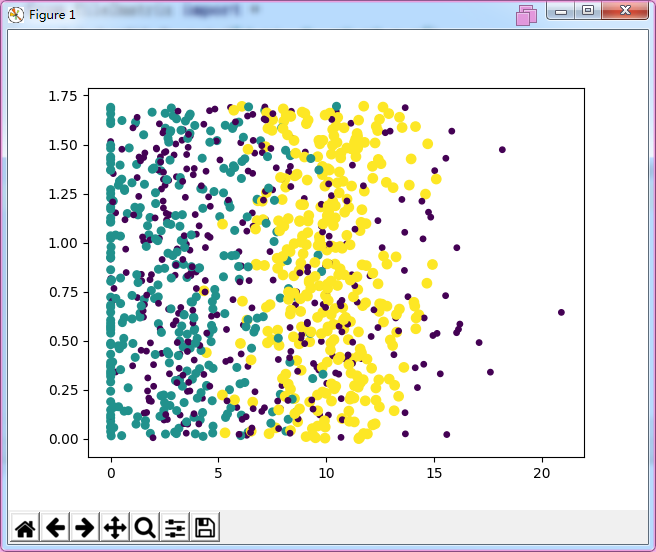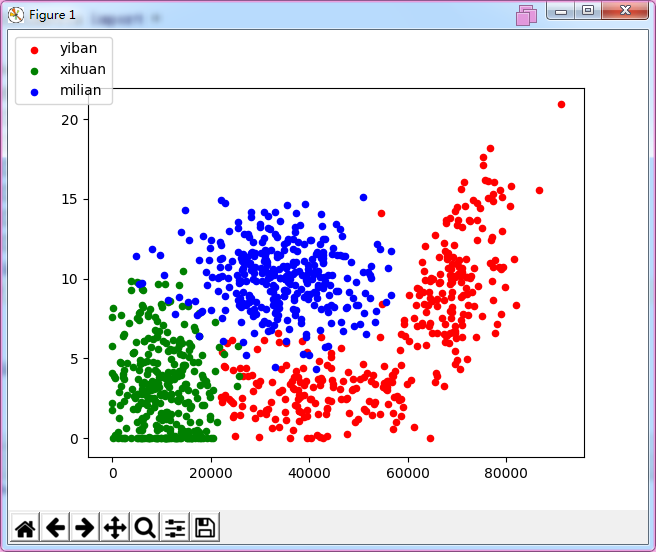=================================版权声明=================================
版权声明:原创文章 禁止转载
请通过右侧公告中的“联系邮箱(wlsandwho@foxmail.com)”联系我
勿用于学术性引用。
勿用于商业出版、商业印刷、商业引用以及其他商业用途。
本文不定期修正完善。
本文链接:http://www.cnblogs.com/wlsandwho/p/7587203.html
耻辱墙:http://www.cnblogs.com/wlsandwho/p/4206472.html
=======================================================================
这个示例实际上是对kNN的练习,区别是使用来自文件的数据。
=======================================================================
1从文件中读取数据并格式化为指定方式。
文件为file2matrix.py
1 from numpy import * 2 ''' 3 def file2matrix1(filename): 4 f=open(filename) 5 arrlines=f.readlines() 6 rows=len(arrlines) 7 retmat=zeros((rows,3)) 8 vctlabels=[] 9 index=0 10 11 for line in arrlines: 12 line=line.strip() 13 list=line.split(" ") 14 retmat[index,0:3]=list[0:3] 15 vctlabels.append(int(list[-1])) 16 index+=1 17 18 return retmat,vctlabels 19 20 mat1,labels1=file2matrix1("datingTestSet2.txt") 21 print(mat1) 22 print(labels1) 23 ''' 24 def file2matrix(filename): 25 with open(filename) as file: 26 line1=file.readline() 27 list1=line1.split() 28 cols=len(list1) 29 file.seek(0,0) 30 lines=file.readlines() 31 rows=len(lines) 32 33 index=0 34 labels=[] 35 realcol=cols-1 36 retmat=zeros((rows,realcol)) 37 for line in lines: 38 list=line.split() 39 retmat[index,:]=list[0:realcol] 40 labels.append(int(list[-1])) 41 42 index+=1 43 return retmat,labels 44 45 def file2matrix2(filename): 46 with open(filename) as file: 47 line1=file.readline() 48 list1=line1.split() 49 cols=len(list1) 50 file.seek(0,0) 51 lines=file.readlines() 52 rows=len(lines) 53 54 index=0 55 labels=[] 56 realcol=cols-1 57 retmat=zeros((rows,realcol)) 58 for line in lines: 59 list=line.split() 60 retmat[index,:]=list[0:realcol] 61 #labels.append(int(list[-1])) 62 if("largeDoses"==list[-1]): 63 labels.append(3) 64 elif("smallDoses"==list[-1]): 65 labels.append(2) 66 elif("didntLike"==list[-1]): 67 labels.append(1) 68 index+=1 69 return retmat,labels
测试一下
文件为test_file2matrix.py
1 from file2matrix import * 2 3 4 mat,labels=file2matrix("datingTestSet2.txt") 5 print(mat) 6 print(labels)
结果(红框是因为我用的虚拟机,不要在意这些细节)

=======================================================================
2 做个图看看相关性/趋势。实际上这里并没有做数学上的讨论,就是画个图看看臆测一下。
文件是drawapicture1.py
1 import matplotlib 2 import matplotlib.pyplot as plt 3 import numpy 4 from file2matrix import * 5 mat,labels=file2matrix("datingTestSet2.txt") 6 nSizeofLabels=len(labels) 7 8 fig=plt.figure() 9 ax=fig.add_subplot(111) 10 ax.scatter(mat[:,1],mat[:,2],s=15.0*array(labels),c=15.0*array(labels)) 11 plt.show()
结果

文件是drawapicture2.py
1 import matplotlib 2 import matplotlib.pyplot as plt 3 import numpy 4 from file2matrix import * 5 6 mat,labels=file2matrix("datingTestSet2.txt") 7 nSizeofLabels=len(labels) 8 mat1x=[] 9 mat2x=[] 10 mat3x=[] 11 mat1y=[] 12 mat2y=[] 13 mat3y=[] 14 for i in range(nSizeofLabels): 15 if labels[i]==1: 16 mat1x.append(mat[i][0]) 17 mat1y.append(mat[i][1]) 18 elif labels[i]==2: 19 mat2x.append(mat[i][0]) 20 mat2y.append(mat[i][1]) 21 elif labels[i]==3: 22 mat3x.append(mat[i][0]) 23 mat3y.append(mat[i][1]) 24 25 fig=plt.figure() 26 ax=fig.add_subplot(111) 27 lg1=ax.scatter(mat1x,mat1y,s=20,c='red') 28 lg2=ax.scatter(mat2x,mat2y,s=20,c='green') 29 lg3=ax.scatter(mat3x,mat3y,s=20,c='blue') 30 fig.legend((lg1,lg2,lg3),('yiban','xihuan','milian'),"upper left") 31 plt.show()
结果是

=======================================================================
3 由于不同意义的数据的取值范围很大,所以需要归一化。
文件是matrixnormalization.py
1 from numpy import * 2 3 def autonorm(mat): 4 minv=mat.min(0) 5 maxv=mat.max(0) 6 diff=maxv-minv 7 rows=mat.shape[0] 8 normmat=zeros(shape(mat)) 9 normmat=mat-tile(minv,(rows,1)) 10 normmat=normmat/tile(diff,(rows,1)) 11 return normmat,minv,maxv,diff
测试归一化
文件是test_matrixnormalization.py
1 from matrixnormalization import * 2 3 4 mat=array([[1,20,3000],[5,60,7000],[2,30,3],[6,60,6000]]) 5 normmat=autonorm(mat) 6 print(normmat)
结果(不知道为何,跟书上的结果不太一样。)

=======================================================================
4测试一下这个分类器的效果
文件名test_dating.py
1 from file2matrix import * 2 from matrixnormalization import * 3 from kNN import * 4 5 6 def testdating(): 7 ratio=0.1 8 countforerr=0 9 10 mat,lab=file2matrix2("datingTestSet.txt") 11 12 normmat,minv,maxv,diff=autonorm(mat) 13 14 allrows=normmat.shape[0] 15 rowsforTest=int(allrows*ratio) 16 17 for i in range(rowsforTest): 18 res=classify_kNN(normmat[i,:],normmat[rowsforTest:allrows,:],lab[rowsforTest:allrows],3) 19 print('the result is',res,'the real is',lab[i]) 20 if (res!=lab[i]): 21 countforerr+=1.0 22 23 print("the error rate is", (countforerr/float(allrows))) 24 25 26 testdating()
结果

=======================================================================
5支持手工输入
文件名test_dating2.py
1 from file2matrix import * 2 from matrixnormalization import * 3 from kNN import * 4 5 6 def testdating(): 7 ratio=0.1 8 countforerr=0 9 reslist=["not at all","a little","very well"] 10 mat,lab=file2matrix2("datingTestSet.txt") 11 12 normmat,minv,maxv,diff=autonorm(mat) 13 14 allrows=normmat.shape[0] 15 rowsforTest=int(allrows*ratio) 16 17 percenttats=float(input("percentage of time spent playing video games?")) 18 flymiles=float(input("frequent filer miles earned per year?")) 19 icecream=float(input("liters of ice cream consumed per year?")) 20 desarr=array([flymiles,percenttats,icecream]) 21 normdesarr=(desarr-minv)/diff 22 23 res=classify_kNN(normdesarr,normmat[rowsforTest:allrows,:],lab[rowsforTest:allrows],3) 24 print("You will probably like this person:",reslist[res-1]) 25 26 27 28 testdating()
结果

=======================================================================
这一节更像是用一个小算法领着学习python。